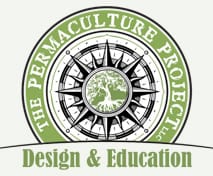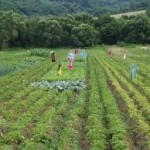Hear is a small portion of a lecture that I gave in Southern Georgia recently:
On my way down here I was thinking a lot about the word agriculture and the word Permaculture, some of the terminology that we use as a culture, that we’ve grown up with, and how some of it is just false. Driving through Illinois, I’m from southern Illinois, it’s considered the breadbasket of the country. But they’re not really producing enough wheat for it to be the breadbasket of the country. It’s mostly soy and corn that gets shipped to hogs in North Carolina, and then the pork gets shipped back to Illinois to be sold in supermarkets. So breadbasket? I don’t think so anymore. Maybe at one time in the history of agriculture in the Midwest this was true, but I don’t think it holds true anymore.
The word agriculture has its roots in the word culture that either meant to till the land or to care for the land. It would be interesting to trace the etymology and find out where it separates. And then agri comes from a Latin root which means “field.” So it either means to till the fields or to care for the fields. Bill Mollison, the creator of Permaculture, coined the word in the 1970s to mean “permanent agriculture,” meaning that he wanted us to develop perennial systems rather than strictly annual systems, although under such a comprehensive system as Permaculture, annual crops are just fine. But one of the goals is to shoot for perennial systems. Here’s an example: if you plant an acre of corn as opposed to an acre of chestnuts, you’ll get ten times the biomass from an acre of chestnuts and just as many functions from chestnuts as you will from corn. Additionally, chestnut contains similar nutrients and starches that you find in rice. But because of the fact that we’ve grown up a certain way and we have very specific tastes, and that the powers that be have placed them in the marketplace for us, we wouldn’t even consider the chestnut as an excellent protein- and mineral-rich flour that we could use in place of standard flour. That’s just one small example.
What Mollison did was, rather than thinking of permanent agriculture, he now took the agri out and called it “permanent culture,” because we’re not strictly dealing with agriculture per se, but the built environment, the waste stream, the biological systems, energy systems, and animals. So it became more of an all-encompassing lifestyle. It’s not what I hear from a lot of people now: we’re going to Permaculture our backyard. It’s much larger than that. We’re not interested in putting a photovoltaic system on a house and saying that we’re “doing Permaculture.” What we do is look at the entire property and think about first of all, what’s there – what are the natural forces that are circulating through the property and what is leaving the property? What we try to do is make use of these forces plus what we call “the biological intelligence” of the region.
In biological systems there is no waste. Everything is recycled and reused for the continuance of life that is happening cyclically over and over and over again.
In the culture that we’ve developed by creating all kinds of gadgets and toys for ourselves – and I’m part of it, I’m not putting it down because the technology we’ve developed is absolutely brilliant and we couldn’t just throw it all out the door – we try, in Permaculture, to open all that up. We say that the problem is the solution. So in the issues and constraints that we’ve created for ourselves, we’re trying to look at it for what it is and either transform it into something that brings health to a landscape or to find an alternative, to look back into other cultures and find ways to bring that into our culture and develop a balanced landscape, both for ourselves and all the other creatures that move about our landscape.
The big question for me is, how do we transition from the agriculture of central Illinois, a single crop like soybeans, to something like a farm, for example, up in Wisconsin where they’re growing hazelnuts, but in between the hazelnuts they’re growing a whole variety of crops until the hazelnut trees become mature and they can take a crop off the hazelnut trees. There are about 80 different species of crops that are growing at this particular Wisconsin farm. It’s one of the most beautiful farms I’ve ever visited. If we think out how to place these crops in the landscape based on landform and climate and rainfall averages – this all works.
In Permaculture, it’s a design system. We say if you take 100 hours of design, it will be an hour of work. I know from many years of experience that if I think through something for an hour, it’s going to take me 100 hours of work. I’ve been through it too many times! And when Permaculture first showed up in the ‘70s, and Bill Mollison’s big book Permaculture: A Designer’s Manual came out on the market, it blew my mind. I had been into all of these different things and it put it all together for me.
So it’s a system, that if you want to jump in, I really recommend it. It’s a very general and comprehensive way of looking at the world, how to produce high yields for ourselves, but also how to care for the earth and care for people and to redistribute the wealth of the harvest. Going through all the literature of the past 30 years, I have yet to come across something as comprehensive as this.
So how do we get away from the monocultural, one crop at a time, all the hedgerows ripped out and replaced with fenceline, going on for thousands of acres? I was driving down to Texas a few years ago to teach and I was going through Arkansas. I looked over and they were doing the cotton harvest. And there was nobody in the tractor! This thing was moving along on the land. It was run by GPS. I thought to myself that this is very absurd, that we’ve come to the point where we don’t even get in the tractor, let alone get out of it and go and feel what the soil is like. We are that far removed.
One of the other things that Permaculture looks at is that we would like to get back to working with small, intensive systems. There are 28 million acres of back and front yards in America. I want you to try to conceive of what that means. Just think of an acre: 53,000 and some square feet. Multiply that by 28 million. I was working on a farm up until two years ago in Illinois, a farm that I had managed for 15 years. I retired two years ago because my body was falling apart – it was too work intensive. It was strictly an organic farm, a market farm, but now I’m working on my sixth of an acre in town and in the first year, my family and I produced 50% of our food needs. Yes it can be done. By stacking many functions together, utilizing horizontal and vertical space we can insert many plant species in the thousands of niches that we find in a landscape. We are so accustomed to broad scale, monocultural “farms” across thousands of acres that we cannot break the habit: crops in neat, linear rows, behemoth tractors stirring the soil and injecting seeds, harvest with nary a human hand close to the plants being harvested.


